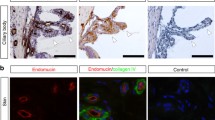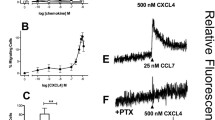Abstract
The surface-expressed transmembrane CX3C chemokine ligand 1 (CX3CL1/fractalkine) induces firm adhesion of leukocytes expressing its receptor CX3CR1. After shedding by the disintegrins and metalloproteinases (ADAM) 10 and 17, CX3CL1 also acts as soluble leukocyte chemoattractant. Here, we demonstrate that transmembrane CX3CL1 expressed on both endothelial and epithelial cells induces leukocyte transmigration. To investigate the underlying mechanism, we generated CX3CR1 variants lacking the intracellular aspartate-arginine-tyrosine (DRY) motif or the intracellular C-terminus which led to a defect in intracellular calcium response and impaired ligand uptake, respectively. While both variants effectively mediated firm cell adhesion, they failed to induce transmigration and rather mediated retention of leukocytes on the CX3CL1-expressing cell layer. Targeting of ADAM10 led to increased adhesion but reduced transmigration in response to transmembrane CX3CL1, while transmigration towards soluble CX3CL1 was not affected. Thus, transmembrane CX3CL1 mediates leukocyte transmigration via the DRY motif and C-terminus of CX3CR1 and the activity of ADAM10.







Similar content being viewed by others
Abbreviations
- AM:
-
Acetoxymethylester
- ADAM:
-
A disintegrin and a metalloproteinase
- CCL2:
-
CC-chemokine ligand 2
- CX3CL1:
-
CX3C-chemokine ligand 1
- CX3CR1:
-
CX3C-chemokine receptor 1
- ELISA:
-
Enzyme-linked immunosorbent assay
- FCS:
-
Fetal calf serum
- FITC:
-
Fluorescein isothiocyanate
- Gi protein:
-
Inhibitory G protein
- GPCR:
-
G protein-coupled receptor
- hFc:
-
Human IgG1-Fc-fragment
- HUVEC:
-
Human umbilical vein endothelial cells
- ICAM:
-
Intercellular adhesion molecule
- IFN:
-
Interferon
- MMP:
-
Matrix metalloproteinase
- PBMC:
-
Peripheral blood mononuclear cells
- PBS:
-
Phosphate-buffered saline
- PE:
-
Phycoerythrin
- TNF:
-
Tumor necrosis factor
- shRNA:
-
Short hairpin RNA
- wt:
-
Wild-type
References
Springer TA (1994) Traffic signals for lymphocyte recirculation and leukocyte emigration: the multistep paradigm. Cell 76:301–314
Combadiere C, Potteaux S, Gao JL, Esposito B, Casanova S, Lee EJ, Debre P, Tedgui A, Murphy PM, Mallat Z (2003) Decreased atherosclerotic lesion formation in CX3CR1/apolipoprotein E double knockout mice. Circulation 107:1009–1016
Lesnik P, Haskell CA, Charo IF (2003) Decreased atherosclerosis in CX3CR1−/− mice reveals a role for fractalkine in atherogenesis. J Clin Invest 111:333–340
Teupser D, Pavlides S, Tan M, Gutierrez-Ramos JC, Kolbeck R, Breslow JL (2004) Major reduction of atherosclerosis in fractalkine (CX3CL1)-deficient mice is at the brachiocephalic artery, not the aortic root. Proc Natl Acad Sci USA 101:17795–17800
McDermott DH, Fong AM, Yang Q, Sechler JM, Cupples LA, Merrell MN, Wilson PW, D’Agostino RB, O’Donnell CJ, Patel DD, Murphy PM (2003) Chemokine receptor mutant CX3CR1–M280 has impaired adhesive function and correlates with protection from cardiovascular disease in humans. J Clin Invest 111:1241–1250
Ludwig A, Weber C (2007) Transmembrane chemokines: versatile ‘special agents’ in vascular inflammation. Thromb Haemost 97:694–703
Bazan JF, Bacon KB, Hardiman G, Wang W, Soo K, Rossi D, Greaves DR, Zlotnik A, Schall TJ (1997) A new class of membrane-bound chemokine with a CX3C motif. Nature 385:640–644
Garton KJ, Gough PJ, Blobel CP, Murphy G, Greaves DR, Dempsey PJ, Raines EW (2001) Tumor necrosis factor-alpha-converting enzyme (ADAM17) mediates the cleavage and shedding of fractalkine (CX3CL1). J Biol Chem 276:37993–38001
Hundhausen C, Misztela D, Berkhout TA, Broadway N, Saftig P, Reiss K, Hartmann D, Fahrenholz F, Postina R, Matthews V, Kallen KJ, Rose-John S, Ludwig A (2003) The disintegrin-like metalloproteinase ADAM10 is involved in constitutive cleavage of CX3CL1 (fractalkine) and regulates CX3CL1-mediated cell–cell adhesion. Blood 102:1186–1195
Harrison JK, Jiang Y, Chen S, Xia Y, Maciejewski D, McNamara RK, Streit WJ, Salafranca MN, Adhikari S, Thompson DA, Botti P, Bacon KB, Feng L (1998) Role for neuronally derived fractalkine in mediating interactions between neurons and CX3CR1-expressing microglia. Proc Natl Acad Sci USA 95:10896–10901
Combadiere C, Salzwedel K, Smith ED, Tiffany HL, Berger EA, Murphy PM (1998) Identification of CX3CR1. A chemotactic receptor for the human CX3C chemokine fractalkine and a fusion coreceptor for HIV-1. J Biol Chem 273:23799–23804
Imai T, Hieshima K, Haskell C, Baba M, Nagira M, Nishimura M, Kakizaki M, Takagi S, Nomiyama H, Schall TJ, Yoshie O (1997) Identification and molecular characterization of fractalkine receptor CX3CR1, which mediates both leukocyte migration and adhesion. Cell 91:521–530
Lagane B, Ballet S, Planchenault T, Balabanian K, Le Poul E, Blanpain C, Percherancier Y, Staropoli I, Vassart G, Oppermann M, Parmentier M, Bachelerie F (2005) Mutation of the DRY motif reveals different structural requirements for the CC chemokine receptor 5-mediated signaling and receptor endocytosis. Mol Pharmacol 67:1966–1976
Berchiche YA, Chow KY, Lagane B, Leduc M, Percherancier Y, Fujii N, Tamamura H, Bachelerie F, Heveker N (2007) Direct assessment of CXCR4 mutant conformations reveals complex link between receptor structure and G(alpha)(i) activation. J Biol Chem 282:5111–5115
Slice LW, Wong HC, Sternini C, Grady EF, Bunnett NW, Walsh JH (1994) The conserved NPXnY motif present in the gastrin-releasing peptide receptor is not a general sequestration sequence. J Biol Chem 269:21755–21761
Barak LS, Tiberi M, Freedman NJ, Kwatra MM, Lefkowitz RJ, Caron MG (1994) A highly conserved tyrosine residue in G protein-coupled receptors is required for agonist-mediated beta 2-adrenergic receptor sequestration. J Biol Chem 269:2790–2795
Ribas C, Penela P, Murga C, Salcedo A, García-Hoz C, Jurado-Pueyo M, Aymerich I, Mayor F (2007) The G protein-coupled receptor kinase (GRK) interactome: role of GRKs in GPCR regulation and signaling. Biochim Biophys Acta 1768:913–922
Fong AM, Robinson LA, Steeber DA, Tedder TF, Yoshie O, Imai T, Patel DD (1998) Fractalkine and CX3CR1 mediate a novel mechanism of leukocyte capture, firm adhesion, and activation under physiologic flow. J Exp Med 188:1413–1419
Haskell CA, Cleary MD, Charo IF (1999) Molecular uncoupling of fractalkine-mediated cell adhesion and signal transduction. Rapid flow arrest of CX3CR1-expressing cells is independent of G-protein activation. J Biol Chem 274:10053–10058
Andrzejewski MG, Koelsch A, Kogel T, Dreymueller D, Schwarz N, Ludwig A (2010) Distinct role of the intracellular C-terminus for subcellular expression, shedding and function of the murine transmembrane chemokine CX3CL1. Biochem Biophys Res Commun 395:178–184
Hundhausen C, Schulte A, Schulz B, Andrzejewski MG, Schwarz N, von Hundelshausen P, Winter U, Paliga K, Reiss K, Saftig P, Weber C, Ludwig A (2007) Regulated shedding of transmembrane chemokines by the disintegrin and metalloproteinase 10 facilitates detachment of adherent leukocytes. J Immunol 178:8064–8072
Pruessmeyer J, Martin C, Hess FM, Schwarz N, Schmidt S, Kogel T, Hoettecke N, Schmidt B, Sechi A, Uhlig S, Ludwig A (2010) A disintegrin and metalloproteinase 17 (ADAM17) mediates inflammation-induced shedding of syndecan-1 and-4 by lung epithelial cells. J Biol Chem 285:555–564
Dirks WG, MacLeod RA, Drexler HG (1999) ECV304 (endothelial) is really T24 (bladder carcinoma): cell line cross-contamination at source. In Vitro Cell Dev Biol Anim 35:558–559
Ludwig A, Berkhout T, Moores K, Groot P, Chapman G (2002) Fractalkine is expressed by smooth muscle cells in response to IFN-gamma and TNF-alpha and is modulated by metalloproteinase activity. J Immunol 168:604–612
Rot A, von Andrian UH (2004) Chemokines in innate and adaptive host defense: basic chemokinese grammar for immune cells. Annu Rev Immunol 22:891–928
Ben Baruch A, Bengali KM, Biragyn A, Johnston JJ, Wang JM, Kim J, Chuntharapai A, Michiel DF, Oppenheim JJ, Kelvin DJ (1995) Interleukin-8 receptor beta. The role of the carboxyl terminus in signal transduction. J Biol Chem 270:9121–9128
Kerfoot SM, Lord SE, Bell RB, Gill V, Robbins SM, Kubes P (2003) Human fractalkine mediates leukocyte adhesion but not capture under physiological shear conditions; a mechanism for selective monocyte recruitment. Eur J Immunol 33:729–739
Ludwig A, Hundhausen C, Lambert MH, Broadway N, Andrews RC, Bickett DM, Leesnitzer MA, Becherer JD (2005) Metalloproteinase inhibitors for the disintegrin-like metalloproteinases ADAM10 and ADAM17 that differentially block constitutive and phorbol ester-inducible shedding of cell surface molecules. Comb Chem High Throughput Screen 8:161–171
Niess JH, Brand S, Gu X, Landsman L, Jung S, McCormick BA, Vyas JM, Boes M, Ploegh HL, Fox JG, Littman DR, Reinecker HC (2005) CX3CR1-mediated dendritic cell access to the intestinal lumen and bacterial clearance. Science 307:254–258
Roland J, Murphy BJ, Ahr B, Robert-Hebmann V, Delauzun V, Nye KE, Devaux C, Biard-Piechaczyk M (2003) Role of the intracellular domains of CXCR4 in SDF-1-mediated signaling. Blood 101:399–406
Kraft K, Olbrich H, Majoul I, Mack M, Proudfoot A, Oppermann M (2001) Characterization of sequence determinants within the carboxyl-terminal domain of chemokine receptor CCR5 that regulate signaling and receptor internalization. J Biol Chem 276:34408–34418
Murdoch C, Finn A (2000) Chemokine receptors and their role in inflammation and infectious diseases. Blood 95:3032–3043
Samstag Y, Eibert SM, Klemke M, Wabnitz GH (2003) Actin cytoskeletal dynamics in T lymphocyte activation and migration. J Leukoc Biol 73:30–48
Ludwig A, Petersen F, Zahn S, Gotze O, Schroder JM, Flad HD, Brandt E (1997) The CXC-chemokine neutrophil-activating peptide-2 induces two distinct optima of neutrophil chemotaxis by differential interaction with interleukin-8 receptors CXCR-1 and CXCR-2. Blood 90:4588–4597
Haskell CA, Cleary MD, Charo IF (2000) Unique role of the chemokine domain of fractalkine in cell capture. Kinetics of receptor dissociation correlate with cell adhesion. J Biol Chem 275:34183–34189
Pruessmeyer J, Ludwig A (2009) The good, the bad and the ugly substrates for ADAM10 and ADAM17 in brain pathology, inflammation and cancer. Semin Cell Dev Biol 20:164–174
Acknowledgments
We thank Tanja Kogel and Melanie Esser for expert technical assistance. This work was supported in part by the IZKF Aachen, and by the Deutsche Forschungsgemeinschaft (SFB542, A12, and FOR809, P5).
Author information
Authors and Affiliations
Corresponding author
Electronic supplementary material
Below is the link to the electronic supplementary material.
SUPPLEMENTAL FIGURE 1:
HUVEC were stimulated with IFN-γ and TNF-α (both 10 ng/ml) to induce endogenous CX3CL1 expression or left unstimulated for 16 h. Subsequently, cells were incubated in the absence or presence of exogenous soluble CX3CL1 (10 nM) for 1 h to investigate potential surface binding of the chemokine. Subsequently, cells were fixed, permeabilized, and stained for CX3CL1 (red) as described [20]. Nuclei were stained in blue. Scale bars represent 20 µm (PPT 3790 kb)
Rights and permissions
About this article
Cite this article
Schwarz, N., Pruessmeyer, J., Hess, F.M. et al. Requirements for leukocyte transmigration via the transmembrane chemokine CX3CL1. Cell. Mol. Life Sci. 67, 4233–4248 (2010). https://doi.org/10.1007/s00018-010-0433-4
Received:
Revised:
Accepted:
Published:
Issue Date:
DOI: https://doi.org/10.1007/s00018-010-0433-4




